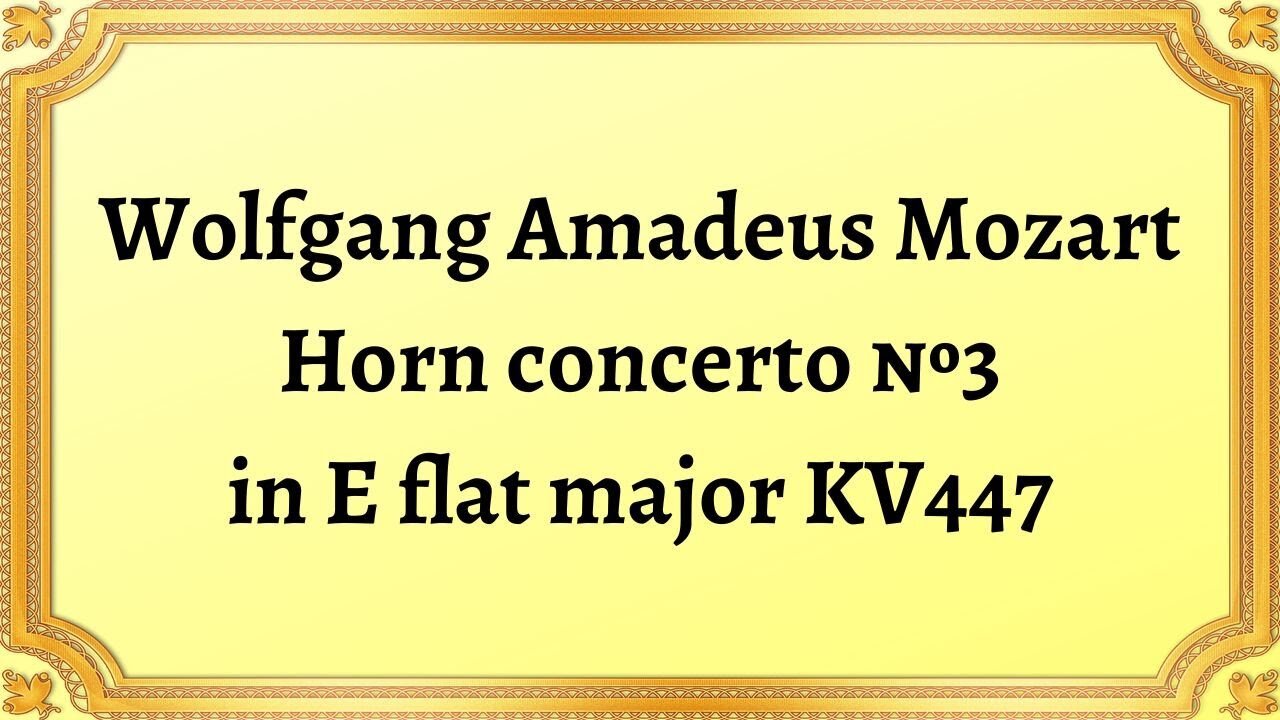Premium Only Content

Wolfgang Amadeus Mozart Horn concerto №3 in E flat major KV447
#Mozart#Chamber_music#Classical_music#Concerto#Musical_composition
Publication date 1955
Franz Koch, horn
Wiener Symphoniker c.b. Bernhard Paumgartner
Francesco Geminiani was a prominent Baroque composer and violinist, best known for his contribution to the development of the concerto grosso genre. One of his most notable works is the "Concerto Grosso in E Op. 3 No. 6," which is a brilliant example of the grandeur, elegance, and technical virtuosity of the Baroque era.
The "Concerto Grosso in E Op. 3 No. 6" is a musical composition written for two violins, viola, cello, and harpsichord. The piece comprises four movements, namely Preludio (Largo), Allegro, Adagio, and Allegro. The opening movement, Preludio, sets the tone for the entire concerto with its solemn and contemplative melody. The second movement, Allegro, is a lively dance piece with intricate interplay between the soloists and the orchestra. The Adagio, a slow and mournful movement, features the solo violin in a soulful and expressive manner. The final Allegro movement is a fast and energetic piece that showcases the virtuosity of the soloists with rapid-fire passages and complex interplay between the ensemble and the soloists.
The "Concerto Grosso in E Op. 3 No. 6" is an excellent example of the concerto grosso form, which alternates between a small group of soloists and the larger orchestra. This form creates a dynamic and nuanced interplay between the soloists and the ensemble, resulting in a rich and complex sound that is emblematic of Baroque music. Additionally, the piece showcases Geminiani's technical prowess and virtuosity as a violinist, with many challenging passages requiring a high degree of technical proficiency and precision, particularly for the soloists.
The "Concerto Grosso in E Op. 3 No. 6" has become a popular and enduring work in the classical music canon, and has been performed and recorded by many notable musicians and orchestras. Its lasting popularity is a testament to its enduring artistic value and its ability to captivate audiences with its complexity, emotional expressiveness, and technical brilliance.
In conclusion, the "Concerto Grosso in E Op. 3 No. 6" by Francesco Geminiani is a masterpiece of the Baroque era, exemplifying the composer's mastery of the concerto grosso form and technical virtuosity. Its enduring popularity among musicians and audiences alike speaks to its lasting artistic value and its ability to inspire and captivate listeners with its beauty and complexity.
-
 20:26
20:26
Classical music_Music Inspiration
1 month agoJohann Sebastian Bach Orchestral Suite No. 2 in B minor, BWV 1066
902 -
 1:18:23
1:18:23
vivafrei
3 hours agoGhislaine Quiety Moved to Texas Facility? Tish Sues Trump Over Trans E.O. Canada Madness & MORE!
70K45 -
 LIVE
LIVE
Akademiks
6 hours agoShannon Sharpe FIRED. KSOO Found Guilty! Gilbert Arenas ARRESTED! NBA Youngboy 14th kid OTW. 1/30
1,038 watching -
 2:09:16
2:09:16
Tucker Carlson
4 hours agoCandace Owens: Macron, Harvey Weinstein, and Why “Christ Is King” Totally Broke People’s Brains
100K211 -
 55:15
55:15
Michael Button
7 hours ago $0.43 earnedWhy Does This Ancient Symbol Appear Everywhere? - Archaic Lens Interview
3.63K1 -
 2:03:12
2:03:12
Side Scrollers Podcast
6 hours agoBlabs is Absolutely DISGUSTED By Nintendo | Side Scrollers Live
23.3K4 -
 10:40
10:40
MTNTOUGH Podcast w/ Dustin Diefenderfer
7 hours agoBack with the 75th Ranger Regiment: MTNTOUGH Dives Deeper into America's Elite
4.9K1 -
 1:07:23
1:07:23
SportsPicks
5 hours agoCrick's Corner: Episode 57
9.13K -
 59:32
59:32
Sean Unpaved
5 hours agoNasty Boy Unleashed: World Series Champ Rob Dibble Unloads on the MLB & Trade Deadline
33K -
 1:46:15
1:46:15
Lara Logan
15 hours agoLAWFARE UNDER FIRE: Treniss Evans Leading the Charge Against a Weaponized Justice System | Ep 29
28.5K1